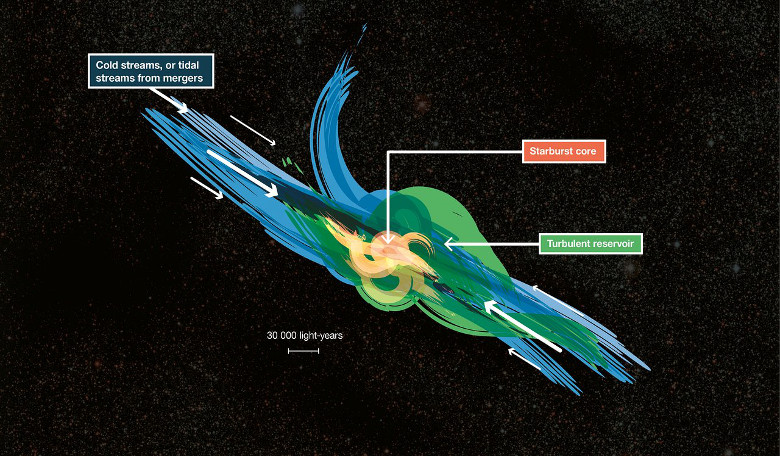The discovery of a molecule that sheds new light on how galaxies extend their period of rapid star formation has been found for the first time in the distant Universe by astronomers using ALMA.
The simple molecule is carbon hydride (CH+); one of the first three molecules ever discovered in the interstellar medium. It was first discovered in the early 1940s, but its presence has proved somewhat of a mystery because it is extremely reactive and accordingly disappears more quickly than other molecules.
This time around, CH+ has been found in a number of starburst galaxies, including the Cosmic Eyelash – a galaxy that is about 10 billion light years away and is producing stars at a rate that is equivalent to about 250 Suns per year. As the name and the statistics imply, starburst galaxies are known for a much higher rate of star formation compared to relatively sedate galaxies like our own Milky Way, making these structures ideal laboratories in which to study the interplay between gas, dust, and stars and consequently what fuels galaxy growth.
“CH+ is a special molecule. It needs a lot of energy to form and is very reactive, which means its lifetime is very short and it can’t be transported far. CH+ therefore traces how energy flows in the galaxies and their surroundings,” said Martin Zwaan, an astronomer at ESO, who contributed to the paper recently submitted to Nature.
Observations by the team, led by Edith Falgarone from the Ecole Normale Supérieure and Observatoire de Paris, France, show that CH+ is tracing dense shock waves that are powered by hot, fast galactic winds originating inside the galaxies’ star forming regions. Although these winds help to transport material out of the galaxy, some material can be recaptured by the enormous gravitational pull of the galaxy itself. When this occurs, the material is fed into huge turbulent reservoirs of cool, low-density gas, that streams more than 30 000 light-years from the galaxy’s star forming region.
“With CH+, we learn that energy is stored within vast galaxy-sized winds and ends up as turbulent motions in previously unseen reservoirs of cold gas surrounding the galaxy,” said Falgarone. “Our results challenge the theory of galaxy evolution. By driving turbulence in the reservoirs, these galactic winds extend the starburst phase instead of quenching it.”
This suggestion helps bolster the current theory that either galactic mergers or accretion from hidden streams of gas are responsible for replenishing material needed for star formation.
These turbulent reservoirs of diffuse gas identified by the team, may also be the same stuff that makes up the giant glowing halos seen around distant quasars. However, further observations are needed to ascertain whether this is the case or not.
Nonetheless, as far as CH+ in star formation is concerned Rob Ivison, a co-author on the paper and ESO’s Director for Science explains the significance of this recent discovery; “it represents a major step forward in our understanding of how the inflow of material is regulated around the most intense starburst galaxies in the early Universe. It shows what can be achieved when scientists from a variety of disciplines come together to exploit the capabilities of the world's most powerful telescope.”











